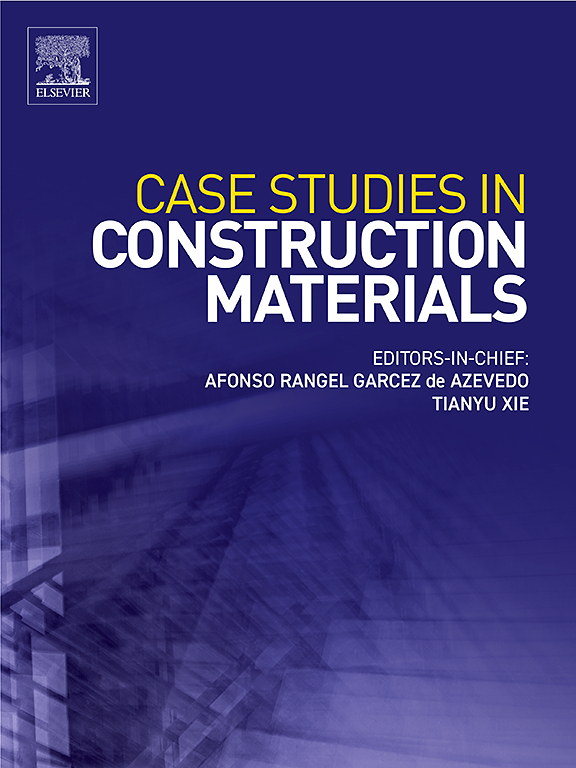临时路面3D打印可重复使用混凝土板的疲劳性能
IF 6.6
2区 工程技术
Q1 CONSTRUCTION & BUILDING TECHNOLOGY
引用次数: 0
摘要
为探究3D打印临时路面可重复使用混凝土板的疲劳性能,通过216个3D打印试件的弯曲疲劳试验,研究不同钢纤维体积比和纤维长度对混凝土板抗弯抗拉强度和疲劳性能的影响。采用双参数威布尔分布建立了不同失效概率下的疲劳寿命计算方法,并推导了相应的疲劳方程。此外,开发了适用于3D打印可重复使用预制路面的疲劳系数,并对路面设计程序进行了修订。研究发现,在3D打印试件中加入钢纤维可以有效防止横向裂纹的发展和扩展,显著提高构件的抗弯拉强度、抗裂性能和抗疲劳性能,使构件的破坏模式从突然脆性破坏转变为韧性塑性破坏。钢纤维的体积比和长度对构件的抗折强度和疲劳寿命有显著影响。在相同应力比S= 0.65的情况下,当ρflf/df由0.00增加到0.60时,构件的疲劳寿命提高了252 %。新型3D打印可重复使用预制铺装板的长边中间应力水平高于板的中心和角落,这是板的最不利加载位置。20米的现场测试段表明,3D打印板的体积减少了40%,重量减少了35%,体力劳动减少了50%,疲劳寿命比传统的C40混凝土板增加了3倍。该研究的发现对于进一步鼓励3D打印技术在交通领域的应用,以及促进工业智能和工业智能的发展具有极其重要的意义。本文章由计算机程序翻译,如有差异,请以英文原文为准。
Fatigue performance of 3D printed reusable concrete slabs for temporary pavements
To explore the fatigue performance of 3D printed reusable concrete slabs for temporary pavements, the effect of varied steel fiber volume ratios and fiber lengths on flexural tensile strength and fatigue performance was studied through the bending fatigue tests on 216 3D printed specimens. Fatigue life calculation methods for various failure probabilities were developed using the two-parameter Weibull distribution, and the related fatigue equation was then derived. Furthermore, the fatigue coefficient suitable for 3D printed reusable prefabricated pavement was developed, followed by a revision to the pavement design procedure. The study found that incorporating steel fibers into 3D printed specimens can effectively prevent the development and expansion of transverse cracks, significantly improve the flexural tensile strength, crack resistance, and fatigue resistance of components, and transition their failure mode from sudden brittle failure to ductile plastic failure. The steel fiber volume ratios and lengths significantly impact component flexural tensile strength and fatigue life. The fatigue life of the component increased by 252 % when the increased from 0.00 to 0.60 under the same stress ratio S= 0.65. The stress level in the middle of the long side of the new type of 3D printed reusable prefabricated pavement slabs is higher than in the plate's center and corners, and that was the most unfavorable loading position for the slab. The 20-meter field test section shown that the 3D printed slabs could reduce volume by 40 %, weight by 35 %, and manual labor by 50 % while a 3-fold increase in fatigue life compared to traditional C40 concrete slabs. The study's findings are extremely important for further encouraging the use of 3D printing technology in the transportation field, as well as promoting industrial intelligence industrial intelligence and development.
求助全文
通过发布文献求助,成功后即可免费获取论文全文。
去求助
来源期刊

Case Studies in Construction Materials
Multiple-
CiteScore
7.60
自引率
19.40%
发文量
842
审稿时长
63 days
期刊介绍:
Case Studies in Construction Materials provides a forum for the rapid publication of short, structured Case Studies on construction materials. In addition, the journal also publishes related Short Communications, Full length research article and Comprehensive review papers (by invitation).
The journal will provide an essential compendium of case studies for practicing engineers, designers, researchers and other practitioners who are interested in all aspects construction materials. The journal will publish new and novel case studies, but will also provide a forum for the publication of high quality descriptions of classic construction material problems and solutions.
 求助内容:
求助内容: 应助结果提醒方式:
应助结果提醒方式:


